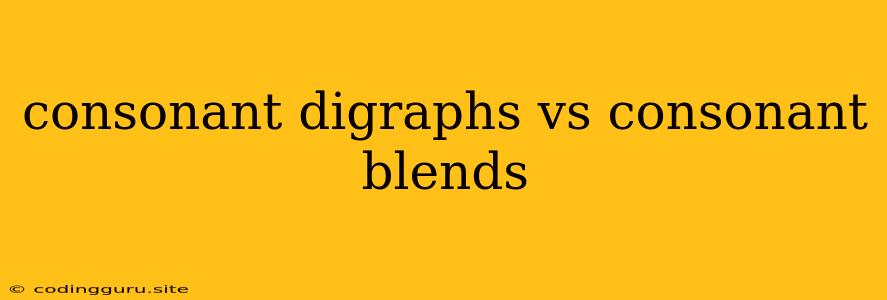Delving into the World of Consonants: Digraphs vs Blends
In the fascinating realm of phonics, understanding the nuances of consonant combinations is crucial for unlocking the secrets of reading and spelling. Two common types of consonant pairings often cause confusion: consonant digraphs and consonant blends.
What are consonant digraphs and consonant blends?
While both involve two consonants working together, they function differently.
Consonant digraphs are two letters that represent a single sound. Think of them as a team working together to create one voice.
Consonant blends are two or more consonants that are blended together, where each consonant sound is heard. Picture them as individuals contributing their unique sounds to a group performance.
How can we tell them apart?
Let's break down some key differences to help you navigate the world of consonant combinations:
Digraphs: One Sound, Two Letters
Examples of Digraphs:
- ch in chair
- sh in ship
- th in think
- wh in where
- ck in duck
- ph in phone
- gh in ghost
Key characteristics of digraphs:
- Single sound: The two letters together represent one distinct sound.
- Consistent pronunciation: The digraph usually produces the same sound across different words.
- Unpredictable spelling: Digraphs can be represented by different letter combinations. For example, the sound /k/ can be represented by "ck" in duck and "c" in cat.
Blends: Multiple Sounds, Multiple Letters
Examples of Blends:
- bl in blue
- fl in fly
- gl in glow
- gr in green
- pl in play
- sl in sleep
- br in brown
- cr in crab
- dr in drum
- fr in frog
- pr in proud
- sc in scar
- sk in sky
- sm in smile
- sn in snow
- sp in spin
- st in star
- sw in swim
- tw in twin
Key characteristics of blends:
- Multiple sounds: Each consonant in the blend contributes its own individual sound.
- Variable pronunciation: The pronunciation of the blend can vary depending on the surrounding letters and the position in the word.
- Predictable spelling: Blends generally maintain the same spelling across different words.
Practical Tips to Distinguish Between Digraphs and Blends
- Sound it out: Say the word aloud. Does the combination of letters create one distinct sound (digraph) or can you hear each individual consonant sound (blend)?
- Look for patterns: Pay attention to common digraph spellings. For example, "th" typically creates the "th" sound, while "tr" creates the blend "tr".
- Remember exceptions: Keep in mind that some words have exceptions to the general rules. For example, the digraph "gh" in "night" is silent.
Examples of Digraphs and Blends in Action
- "The ship sailed through the night." Here, "sh" is a digraph representing one sound, while "th" is a digraph representing a different single sound.
- "The brown dog chased the red ball." "br" and "ch" are blends, each with their own distinct sounds, while "ck" in "ball" represents the single "k" sound, making it a digraph.
Learning the Difference: Importance and Benefits
Mastering the difference between consonant digraphs and blends is crucial for:
- Improving reading skills: Being able to identify these combinations allows readers to decode unfamiliar words more efficiently.
- Enhancing spelling accuracy: Understanding the specific sounds associated with digraphs and blends improves spelling abilities.
- Strengthening phonics foundation: Gaining a solid grasp of these concepts lays the foundation for a comprehensive understanding of English spelling patterns.
Conclusion
While they may look similar, consonant digraphs and blends play distinct roles in the world of phonics. By understanding their unique characteristics and learning to recognize them, you can unlock the secrets of English reading and spelling, paving the way for a more confident and fluent language journey. Remember, practice makes perfect! The more you explore the world of digraphs and blends, the more adept you will become at identifying and utilizing these important linguistic tools.
